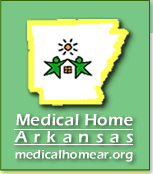| Children's
Medical Services (in the Arkansas Department of
Human Services) in collaboration with the Department
of Developmental Pediatrics in the Department of
Pediatrics at the University of Arkansas for Medical
Sciences received a grant from the federal Maternal
and Child Health Bureau in April 2002 called "Medical
Homes for Children with Special Health Care Needs."
The purpose of this grant is to improve the accessibility
and quality of Medical Homes available to Arkansas
children. The activities of the grant are focused
on educating both physicians and families about
the seven major components of the Medical Home concept
and the characteristics that bring the concept to
life.
A
Medical Home is not a building, house or hospital,
but rather an approach to providing health care
services in a high-quality and cost-effective
manner. Children and their families who have a
medical home receive the care that they need from
a well-trained physician who provides primary
care and helps to manage and facilitate essentially
all aspects of pediatric care. Physicians, families
and allied health care professionals act as partners
in a Medical Home to identify and access all the
medical and non-medical services needed to help
children and their families achieve their maximum
potential.
The
American Academy of Pediatrics (AAP) believes
that the medical care of infants, children, and
adolescents should be accessible, continuous,
comprehensive, family-centered, coordinated, compassionate,
and culturally effective. It should be delivered
or directed by well-trained physicians who provide
primary care and help to manage and facilitate
essentially all aspects of pediatric care. The
physician should be known to the child and family
and should be able to develop a partnership of
mutual responsibility and trust with them. These
characteristics define the "Medical Home".
In contrast to care provided in a Medical Home,
care provided through emergency departments, walk-in
clinics, and other urgent-care facilities, though
sometimes necessary, is more costly and often
less effective.
What
are the benefits of a Medical Home?
- Increased
patient and family satisfaction
- Establishment
of a forum for problem solving
- Improved
coordination of care
- Enhanced
efficiency for children and family
- Efficient
use of limited resources
- Increased
professional satisfaction
- Increased
wellness resulting from comprehensive care
The
desirable characteristics of a Medical Home are
summarized below:
Accessible
- Care
is provided in the child's or youth's community.
- All
insurance, including Medicaid, is accepted.
- Changes
in insurance are accommodated.
- The
practice is accessible by public transportation,
where available
- Families
or youth are able to speak directly to the physician
when needed.
- The
practice is physically accessible and meets
Americans with Disabilities Act requirements.
- The
medical home physician is known to the child
or youth and family.
- Mutual
responsibility and trust exists between the
patient and family and the medical home physician.
Family-Centered
- The
family is recognized as the principal caregiver
and center of strength and support for the child.
- Clear,
unbiased, and complete information and options
are shared on an ongoing basis with the family.
- Families
and youth are supported to play a central role
in care coordination.
- Families,
youth and physicians share responsibility in
decision making.
- The
family is recognized as the expert in their
child's care, and youth are recognized as the
experts in their own care.
Continuous
- The
same primary pediatric health care professionals
are available from infancy through adolescence
and young adulthood.
- Assistance
with transitions, in the form of developmentally
appropriate health assessments and counseling,
is available to the child or youth and family.
- The
medical home physician participates to the fullest
extent allowed in care and discharge planning
when the child is hospitalized or care is provided
at another facility or by another provider.
Comprehensive
- Care
is delivered or directed by a well-trained physician
who is able to manage and facilitate essentially
all aspects of care.
- Ambulatory
and inpatient care for ongoing and acute illnesses
is ensured, 24 hours a day, 7 days a week, 52
weeks a year.
- Preventive
care is provided that includes immunizations,
growth and development assessments, appropriate
screenings, health care supervision, and patient
and parent counseling about health, safety,
nutrition, parenting and psychosocial issues.
- Preventive,
primary, and tertiary care needs are addressed.
- The
physician advocates for the child, youth, and
family in obtaining comprehensive care and shares
responsibility for the care that is provided.
- The
child's or youth's and family's medical, educational,
developmental, psychosocial, and other service
needs are identified and addressed.
- Information
is made available about private insurance and
public resources, including Supplemental Security
Income, Medicaid, the State Children's Health
Insurance Program, waivers, early intervention
programs, and Title V State Programs for Children
with Special Health Care Needs.
- Extra
time for an office visit is scheduled for children
with special health care needs, when indicated.
Coordinated
- A
plan of care is developed by the physician,
child or youth, and family and is shared with
other providers, agencies, and organizations
involved with the care of the patient.
- Care
among multiple providers is coordinated through
the medical home.
- A
central record or database containing all pertinent
medical information, including hospitalizations
and specialty care, is maintained at the practice.
The record is accessible, but confidentiality
is preserved.
- The
medical home physician shares information among
the child or youth, family, and consultant and
provides specific reason for referral to appropriate
pediatric medical subspecialists, surgical specialists,
and mental health/developmental professionals.
- Families
are linked to family support groups, parent-to-parent
groups, and other family resources.
- When
a child or youth is referred for a consultation
or additional care, the medical home physician
assists the child, youth and family in communicating
clinical issues.
- The
medical home physician evaluates and interprets
the consultant's recommendations for the child
or youth and family and, in consultation with
them and subspecialists, implements recommendations
that are indicated and appropriate.
- The
plan of care is coordinated with educational
and other community organizations to ensure
that special health needs of the individual
child are addressed.
Compassionate
- Concern
for the well-being of the child or youth and
family is expressed and demonstrated in verbal
and nonverbal interactions.
- Efforts
are made to understand and empathize with the
feelings and perspectives of the family as well
as the child or youth.
Culturally
Effective
- The
child's or youth's and family's cultural background,
including beliefs, rituals, and customs, are
recognized, valued, respected, and incorporated
into the care plan.
- All
efforts are made to ensure that the child or
youth and family understand the results of the
medical encounter and the care plan, including
the provision of (para)professional translators
or interpreters, as needed.
- Written
materials are provided in the family's primary
language.
The complete policy statement of the AAP on Medical
Home, click
here
If
you are interested in learning how to evaluate
the "medical homeness" of your (primary
care physician's) practice, click
here
|

